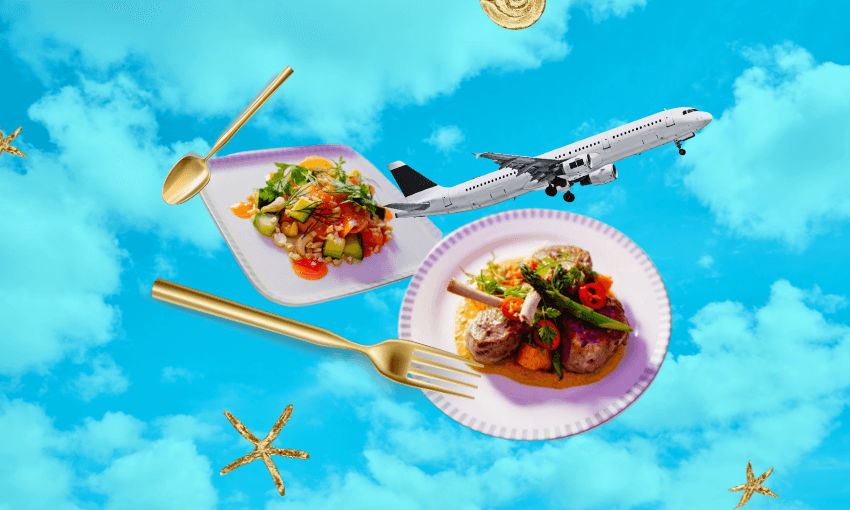What do bloody marys, ginger ale and mushrooms all have in common? They may taste even better when consumed at altitude.
A tomato at sea level is still a tomato at 30,000 feet. But while the tomato remains unchanged between take off and cruising altitude, our perception of it does not. Altitude acts on the human body in peculiar ways, and so does flying in an airplane.
For starters, our perception of smells and tastes is different in the air than on the ground. Research conducted by the Fraunhofer Institute shows that salt, for example, is perceived to be 20 to 30% less salty at altitude. Sweet and salty flavours seem to be the most dramatically dulled by elevation gain. Sour, bitter and spicy elements are similarly affected but less so.
There are lots of reasons for these changes in perception. The lower pressure experienced while flying reduces oxygen saturation in the blood which reduces the effectiveness of olfactory and taste receptors. Essentially, our ability to taste how salty salt is, for example, diminishes. The sensory experience of flying also plays a role. From the flashing TV screens to the sound of the jet engines just outside, an airplane cabin provides more sensory stimuli than, say, your home kitchen. These unfamiliar stimuli are difficult to tune out and this makes it harder to notice small details like flavours. As a result, a higher input (more salt, if we stick with that example) is required to get the same result.
Darryl Tong, Singapore Airlines catering manager, is an expert on these unique dining conditions. Tong confirms that our taste buds genuinely do behave differently while on board a plane. “The cabin environment is something we are mindful of when designing our [in-flight] dishes; due to the pressure and low humidity, taste buds become less sensitive,” he says. To counter this, dishes need to be full-flavoured, with enhanced seasoning that makes certain ingredients stand out. Restaurant dishes, which tend to be more flavoursome and well seasoned than home cooking, translate well to in-flight menus.
When Tong and the team set out to create a new menu for their New Zealand to Singapore routes, they “wanted to find a chef who represented a fresh take on New Zealand cuisine.” A chef who could make flavours sing even at 30,000 feet. Chef and restaurateur Sid Sahrawat was a natural fit. Sahrawat has built a successful career celebrating modern Indian cuisine while championing New Zealand ingredients. Since opening fine dining restaurant Sidart in Auckland in 2009, Sahrawat’s multi award-winning restaurant empire has grown to include Cassia, Sid at the French Cafe, Anise and Kol.
Sahrawat moved from India to New Zealand in 2000, and is no stranger to a long haul flight. When Singapore Airlines reached out to him to help craft an in-flight menu, he was excited. “When they first approached me in 2018, I was super thrilled and humbled to be asked. It’s been a long time in the making, due to the pandemic,” he says.
To kick things off, Sahrawat travelled to Singapore to spend time in the airline’s test kitchens with the catering teams. He was blown away by the processes and attention to detail. Inflight menu creation generally takes nine to 12 months. Each dish is put through vigorous taste tests, visual tests and goes through several rounds of refinement. Tong says a vital factor is figuring out “whether dishes can be produced in large quantities without compromising quality, while utilising the produce and technologies that are available to us.” It’s also about understanding how food will travel, how it will eat, how it will be cooked and plated in the air.
Imagining what he’d crave if he were on a long haul trip, Sahrawat leaned heavily into bold flavours and comfort while trying to maintain an element of surprise. “It still needs to have that x-factor, and feel special enough to match Singapore Airlines’ world class dining standards,” he says. Sahrawat has long been a fan of the airline’s ethos. “For me, Singapore Airlines has always been synonymous with luxury and a commitment to quality. I’ve tried to reflect that in my menu design focusing on the purity of our New Zealand ingredients and letting them shine.” He wanted guests to get a taste of New Zealand through familiar combinations, paired with punchy flavours that could deliver high satisfaction despite the impact altitude has on our taste buds.
So what’s on this new menu? Signature Sahrawat dishes like Canterbury lamb rack with kūmara and korma sauce as well as dishes like pan-seared crayfish with pungent wasabi mayo, macadamia nuts and sweetcorn – Sahrawat’s dream combo when paired with a chilled glass of champagne. Sahrawat thinks New Zealand’s sweetcorn and lamb is some of the best in the world. He’s also called on his heritage for this menu, weaving flavours of India throughout – a line-caught snapper dish features a makhani sauce (a Cassia recipe), served with bok choy and enoki mushrooms. Makhani translates to “with butter” and commonly refers to “butter chicken”. Sahrawat’s version uses tomato paste and cashew nuts in place of butter, lending a velvety texture to the medium spiced sauce which is guaranteed to excite the palate despite the white noise of the aircraft cabin. Cassia fans will rejoice as a take on the restaurant’s famous tandoori chicken sliders also feature. For dessert, there’s an enlivening coffee panna cotta with luscious chocolate custard and bright strawberries.
Sahrawat is off travelling next month, where he will get to fully experience his menu on board. Were he flying today he’d opt for the crayfish starter with macadamia and sweetcorn, the lamb rack for main, finishing with his favourite, a classic Kiwi pavlova with salt baked pineapple and passionfruit curd. Sahrawat’s menu launched March 1st on Singapore Airlines First Class and Business Class cabins on flights departing Auckland and Christchurch. It will run for a limited time only with a planned winter menu launching later this year.
Whether you get a chance to experience this in-air world class restaurant or not, you can still experiment with the sensory changes flying offers. While salty foods lose their edge at altitude, ingredients that are loaded with umami – like parmesan cheese, mushrooms and tomatoes – are often reported to actually taste better while flying. The next time you find yourself on a plane, order a tomato juice. In one past study, nearly 1 in 4 passengers surveyed ordered a tomato juice in the air, despite never drinking it on the ground. Many reported that it tastes less earthy, more acidic and overall more delicious while flying. A bloody mary, with the addition of deeply umami Worcestershire sauce, enhances enjoyment even more. Or, you could just get a ginger ale. Ginger ale’s sweetness takes a back seat at 30,000 feet allowing the dry, sharp, crispness to shine through, making it extra refreshing in this unique environment.


